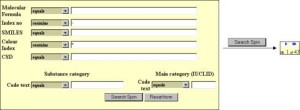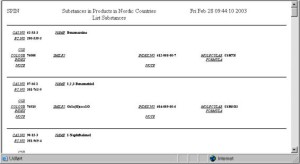4.1 Colouring agents.
4.1 Colouring agents.
It is well-known that some colouring agents, primarily the aromatic ones, are suspected to be harm-ful for humans. Many colouring agents have been tested for dangerous properties, and some of the tested agents are so well investigated that they are on the E.C. List of Dangerous Substances. The remaining colouring agents can not be regarded as harmless just because they are not on the E.C. List of Dangerous Substances. You have to regard them as “not sufficiently investigated”. Is it possible that data in SPIN can give you an overview of all the colouring agents used in the Nordic countries that are also on the E.C. List of Dangerous Substances?
Yes, to a certain extend it is!
In order to find all the colouring agents in SPIN that are on the E.C. List of Dange-rous Substances we make the assumption that all colouring agents have aColour Index number (see section “1.6.6 On-line help – Technical”). Then we combine this with the fact that substances from the E.C. List of Dangerous Substances have a certain Index-No. The relevant substances can then be found by searching in the tab called “Technical” with the criterias “Index-No.” “contains” “-” and “Colour Index” “contains” “*”. This gives you 43 hits. You can now run the report “List Substances” (see section “1.7.3 Reports – using the current found set”) to get an overview of the found substances.

To check whether the found substances really are used as colouring agents, you can switch back to the “Technical” tab and repeat the original search, now with the criteria added that “Code text” “contains” “PI” under “Substance Category” (see section “1.6.6 On-line help – Technical”). This will give you the subset of the original 43 substances that by the Danish Product Register are assumed to be either unspecified pigments (PIG), organic pigments (PIO) or inorganic pigments (PIU).

It turns out that the subset contains only 18 out of the original 43 substances, which could indicate that the fact that a substance has a Colour Index number, does not necessarily mean that the substance is used as a colouring agent. We must however bear in mind, that the subset is only based on Danish data. We can not rule out that the remaining 25 substances are in fact used as colouring agents in the other Nordic countries.
